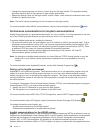
are written for one type of network protocol to run over a different type of network protocol. For example,
without AnyNet, your choice of application program interface (API) dictates your choice of network
protocol, or your choice of network protocol dictates your choice of APIs.
AnyNet allows you to mix and match applications with network protocols. In fact, you can do this without
changing your application programs. Your destination address (such as a remote location) determines the
type of network protocol to use.
v AnyNet/400 Sockets
This support converts TCP/IP addresses to SNA addresses that are based on tables that are configured
by the network administrator. Programs supported include File Transfer Protocol (FTP), Simple Mail
Transfer Protocol (SMTP), Simple Network Management Protocol (SNMP), PING, and user-written
sockets programs.
– TCP/IP over SNA
– TCP/IP over IPX
v AnyNet/400 APPC (advanced program-to-program communications)
This support allows programs that are written to traditional APPC APIs (such as ICF,
CPI-Communications, and CICS/400) to be run over non-APPC networks. The application program uses
Location names to specify the source and destination address. A TCP/IP domain name server converts
these location names to IP addresses. Programs supported include distributed data management
(DDM), Distributed Relational Database Architecture (DRDA), SNA distribution services (SNADS),
display station pass-through, Client Access, user-written CPI-Communications programs, and
user-written ICF programs .
– APPC over TCP/IP
– APPC over IPX
For more information about using both AnyNet and nonAnyNet sockets, see the Sockets Programming
book.
Subsystems
A subsystem is a single, predefined operating environment through which the system coordinates work
flow and resource usage. OS/400 can contain several that are independent operating subsystems. The
run-time characteristics of a subsystem are defined in an object that is called a subsystem description.
IBM supplies several subsystem descriptions that can be used with or without modification:
QINTER
Used for interactive jobs
QBATCH
Used for batch jobs
QBASE
Used for both interactive and communications batch jobs
QCMN
Used for communications batch jobs
QSERVER
File server system
QSYSWRK
Used for general system work
QUSRWRK
This is the default subsystem used for TCP/IP Client Access Host Servers that used to run in
QSYSWRK.
A new subsystem can also be defined with the Create Subsystem Description (CRTSBSD) command.
Chapter 3. Optimizing communications performance 15


















